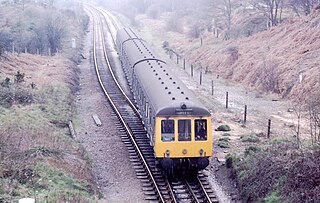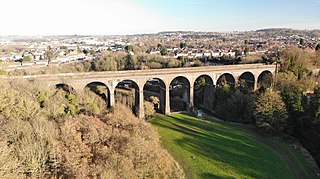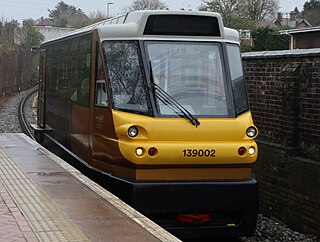
A diesel multiple unit or DMU is a multiple-unit train powered by on-board diesel engines. A DMU requires no separate locomotive, as the engines are incorporated into one or more of the carriages. Diesel-powered single-unit railcars are also generally classed as DMUs. Diesel-powered units may be further classified by their transmission type: diesel–mechanical DMMU, diesel–hydraulic DHMU, or diesel–electric DEMU.

A railcar is a self-propelled railway vehicle designed to transport passengers. The term "railcar" is usually used in reference to a train consisting of a single coach, with a driver's cab at one or both ends. Some railway companies, such as the Great Western, termed such vehicles "railmotors".

A diesel locomotive is a type of railway locomotive in which the power source is a diesel engine. Several types of diesel locomotives have been developed, differing mainly in the means by which mechanical power is conveyed to the driving wheels. The most common are diesel-electric locomotives and diesel-hydraulic.

The British Rail Class 108 diesel multiple units were built by BR Derby from 1958 to 1961, with a final production quantity of 333 vehicles.

The British Rail Class 153 Super Sprinter are single-coach railcars converted from two-coach Class 155 diesel multiple units in the early 1990s. The class was intended for service on rural branch lines, either where passenger numbers do not justify longer trains or to boost the capacity on services with high passenger volume.

The British Rail Class 121 is a single-car double-ended diesel multiple unit. 16 driving motor vehicles were built from 1960, numbered 55020–55035. These were supplemented by ten single-ended trailer vehicles, numbered 56280–56289. They have a top speed of 70 mph (113 km/h), with slam-doors, and vacuum brakes. The driving motor vehicles were nicknamed "Bubble Cars" by some enthusiasts.

The British Rail Class 116 diesel multiple units were built by BR Derby from 1957 to 1961. Introduced as part of the British Railways Modernisation Plan in the mid 1950s, as with other first generation DMUs the 116 was intended to replace steam trains and reduce costs across the rail network. Alongside Metro-Cammell, BR Derby had prior experience with DMUs, having developed a Lightweight Unit, and so was awarded a contract for a new design.

The British Rail Class 104 diesel multiple units were built by Birmingham Railway Carriage and Wagon Company from 1957 to 1959.

The British Rail Classes 101 and 102 diesel-mechanical multiple units were built by Metro-Cammell at Washwood Heath in Birmingham, England from 1956 to 1959, following construction of a series of prototype units. These classes proved to be some of the most successful and longest-lived of BR's First Generation DMUs, second in longevity only to the Class 121, with the final five units being withdrawn on 24 December 2003. The oldest set was, by then, just over 47 years old.

The British Rail Class 127 diesel multiple units were built by BR Derby in 1959. Thirty 4-car units were built, formed of two outer driving motor vehicles, sandwiching two intermediate trailers which were classified class 186. The technical description of such as 4-car unit was DMBS + TSL + TS + DMBS.

The British Rail Class 118 diesel multiple units were built by the Birmingham Railway Carriage and Wagon Company (BRCW) and introduced from 1960. It was a licence-built version of the British Rail Class 116.

The Stourbridge Town branch line is a 0.8-mile (1.3 km) railway branch line, in Stourbridge, West Midlands, England. It is the shortest railway line in Britain. It is widely believed to be the shortest line in Europe to host a daily service, although this is incorrect; it is notably beaten by the branch line to Friedrichshafen Hafen, in Germany.

Stourbridge Junction is one of two railway stations serving the town of Stourbridge, in the Metropolitan Borough of Dudley in the West Midlands, England. It lies on the Birmingham to Worcester via Kidderminster Line and is the junction for the Stourbridge Town Branch Line, said to be the shortest operational branch line in Europe. The other station serving Stourbridge is Stourbridge Town at the end of the branch line.
A hybrid train is a locomotive, railcar or train that uses an onboard rechargeable energy storage system (RESS), placed between the power source and the traction transmission system connected to the wheels. Since most diesel locomotives are diesel-electric, they have all the components of a series hybrid transmission except the storage battery, making this a relatively simple prospect.

Stambermill Viaduct is a viaduct situated in Stourbridge, West Midlands, England. It was constructed in 1850 to carry the Oxford Worcester and Wolverhampton Railway across the River Stour, and it carried passenger trains until 1964. It is still in use for goods trains, as the railway continues on to the Round Oak Steel Terminal at Brierley Hill. Freight trains can still be seen passing over the viaduct.

Brierley Hill railway station was a station on the Oxford-Worcester-Wolverhampton Line serving the town of Brierley Hill in England.

British Rail Class 139 is the TOPS classification for PPM60 model lightweight railcars built by Parry People Movers, for use on the British rail network. The class were originally built in 2008 for operation on the Stourbridge Town branch line following an extensive trial with a prototype registered as a Class 999 unit.
The Rolls-RoyceC range was a series of in-line 4, 6 and 8 cylinder diesel engines used in small locomotives, railcars,construction vehicles, and marine and similar applications. They were manufactured by the Rolls-Royce Oil Engine Division headed by William Arthur Robotham to 1963, initially at Derby and later at Shrewsbury, from the 1950s through to 1970s.

Diesel multiple units and railcars are trains, usually with passenger accommodation, that do not require a locomotive. Railcars can be single cars, while in multiple units cars are marshalled together with a driving position either end. As of December 2010, 23 percent of the rail passenger cars used on Network Rail are part of a diesel multiple unit.

West Midlands Trains (WMT) is a British train operating company. It operates passenger trains on the West Midlands franchise between London and the English Midlands under two trading names: within the West Midlands region as West Midlands Railway (WMR) and outside the region as London Northwestern Railway (LNR).




















